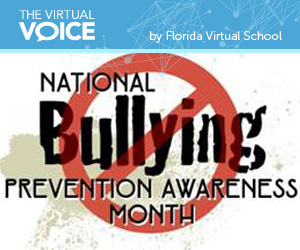National Bullying Prevention Awareness Month
 At one point, bullying was simply considered a rite of passage in childhood.
At one point, bullying was simply considered a rite of passage in childhood.
Today, research shows that bullying has a significant impact on one’s education, health, and safety.
Bullying can negatively impact a child’s education. It is estimated that 160,000 children miss school every day due to fear of attack or intimidation by other students. Research shows 15 percent of all school absenteeism is directly related to fears of being bullied at school.
One out of every 10 students who drops out of school does so because of repeated bullying.
In addition to a negative impact on education, bullying can lead to mental and physical health issues. Students who experience bullying are at increased risk for depression, anxiety, sleep difficulties, and poor school adjustment. Students who bully others are at increased risk for substance use, academic problems, and violence later in adolescence and adulthood. Students who experience bullying are twice as likely as non-bullied peers to experience negative health effects such as headaches and stomachaches.
Bullying also impacts our sense of safety and well-being. Youth victimized by their peers were 2.4 times more likely to report suicidal ideation and 3.3 times more likely to report a suicide attempt than youth who reported not being bullied. Students who are both bullied and engage in bullying behavior are the highest risk group for adverse outcomes.
These sad statistics make it clear that we need to do something about the bullying epidemic! October is bullying prevention and awareness month. Let’s all work together to erase bullying and keep students safe. Check out this quick video to bust some myths about bullying:
Additional bullying resources:
Sources:
- National Education Association: http://www.nea.org
- American Academy of Pediatrics: https://www.aap.org
- US Department of Education, National Center for Educational Statistics (2015). Student Reports of Bullying and Cyberbullying: Results from the 2013 School Crime Supplement to the National Victimization Survey. Retrieved from: http://nces.ed.gov/pubsearch/pubsinfo.asp?pubid=2015056.
- Center for Disease Control, National Center for Injury Prevention and Control (2012). Understanding bullying. Retrieved from: http://www.cdc.gov/violenceprevention/pdf/bullyingfactsheet2012-a.pdf.
- Gini, G., & Pozzoli, T. (2013). Bullied children and psychosomatic problems: A meta-analysis. Pediatrics. Retrieved from: http://pediatrics.aappublications.org/content/early/2013/09/11/peds.2013-0614.
- Espelage, D. L., & Holt, M. K. (2013). Suicidal ideation and school bullying experiences after controlling for depression and delinquency. Journal of Adolescent Health, 53. Retrieved from: http://www.ncdsv.org/images/JAH_Suicidal-ideation-and-school-bullying_7-2013.pdf.

 Amy LaGrasta, Flex School Counseling Senior Manager, helps students make informed decisions about courses, career and college options, and the study habits needed for online success. Prior to joining FLVS, she served as the guidance director at Estero High School in Lee County, FL where she was honored with the Teacher of Distinction award.
Amy LaGrasta, Flex School Counseling Senior Manager, helps students make informed decisions about courses, career and college options, and the study habits needed for online success. Prior to joining FLVS, she served as the guidance director at Estero High School in Lee County, FL where she was honored with the Teacher of Distinction award.